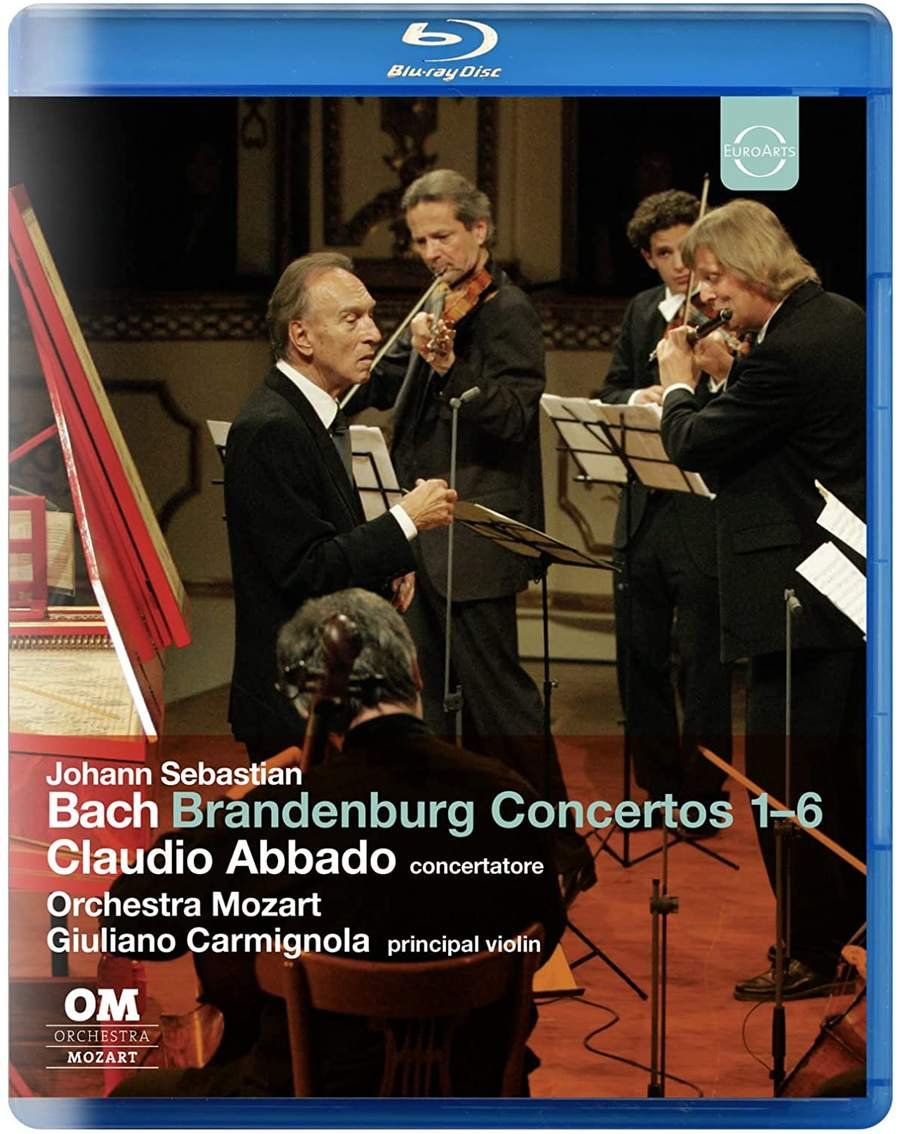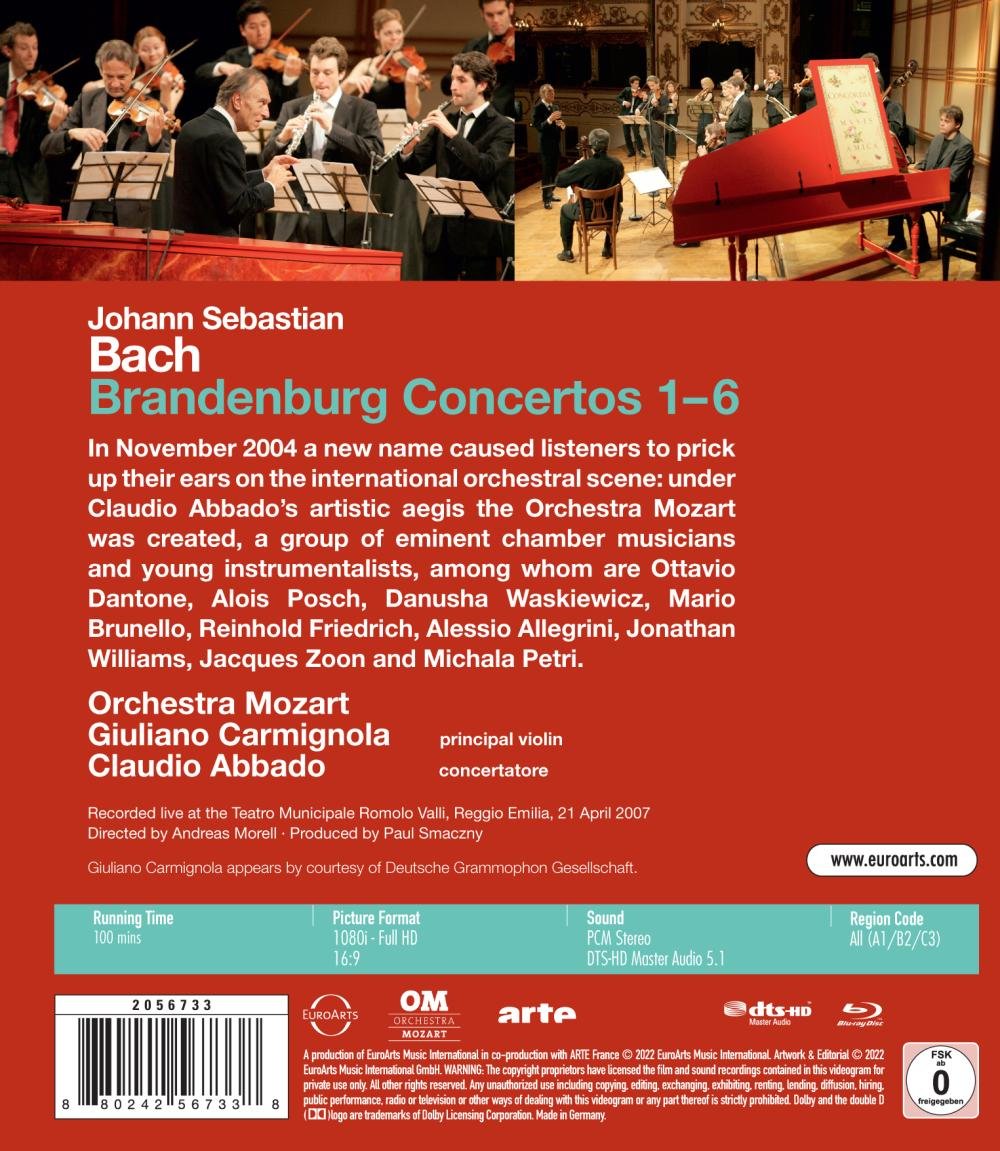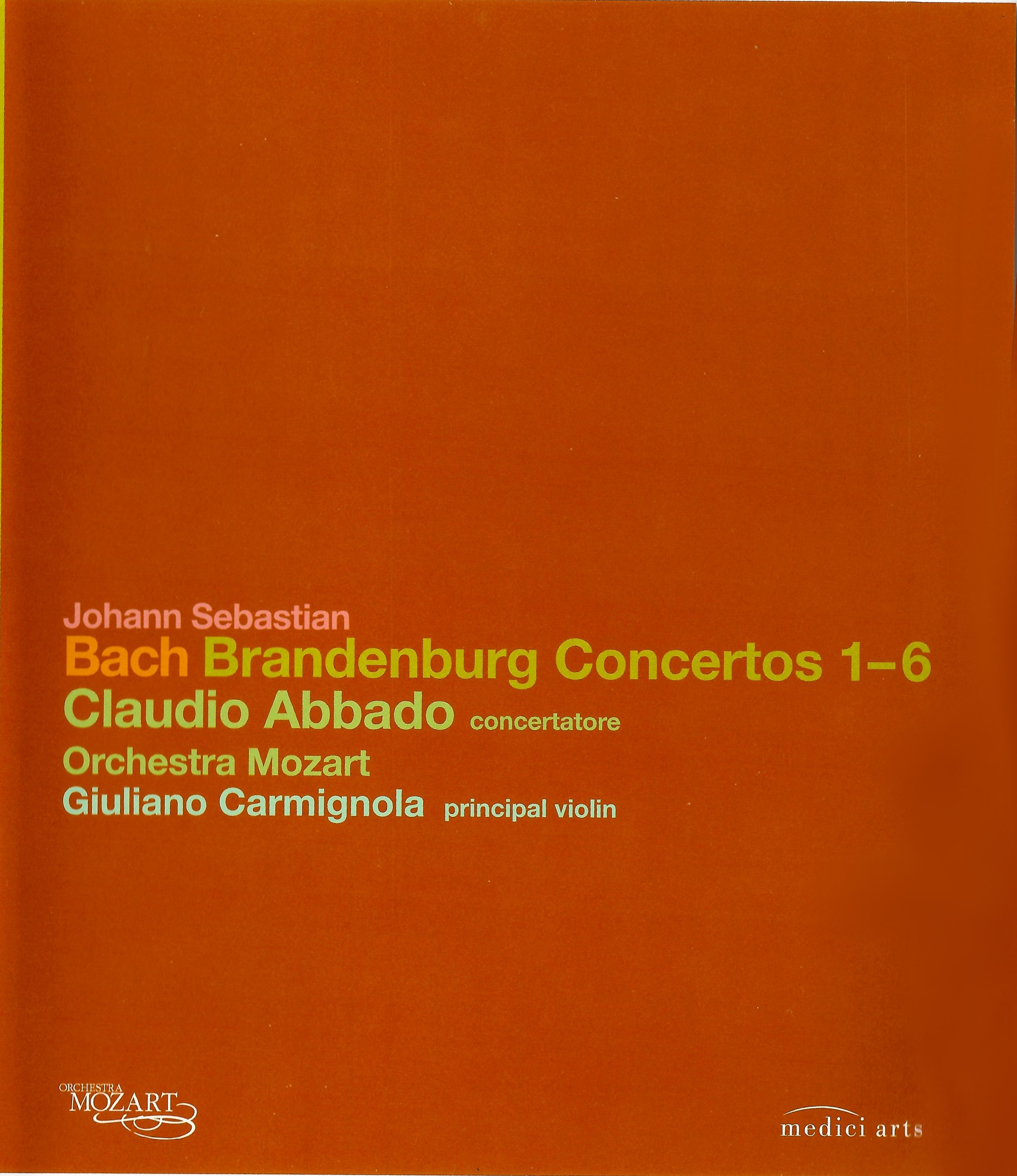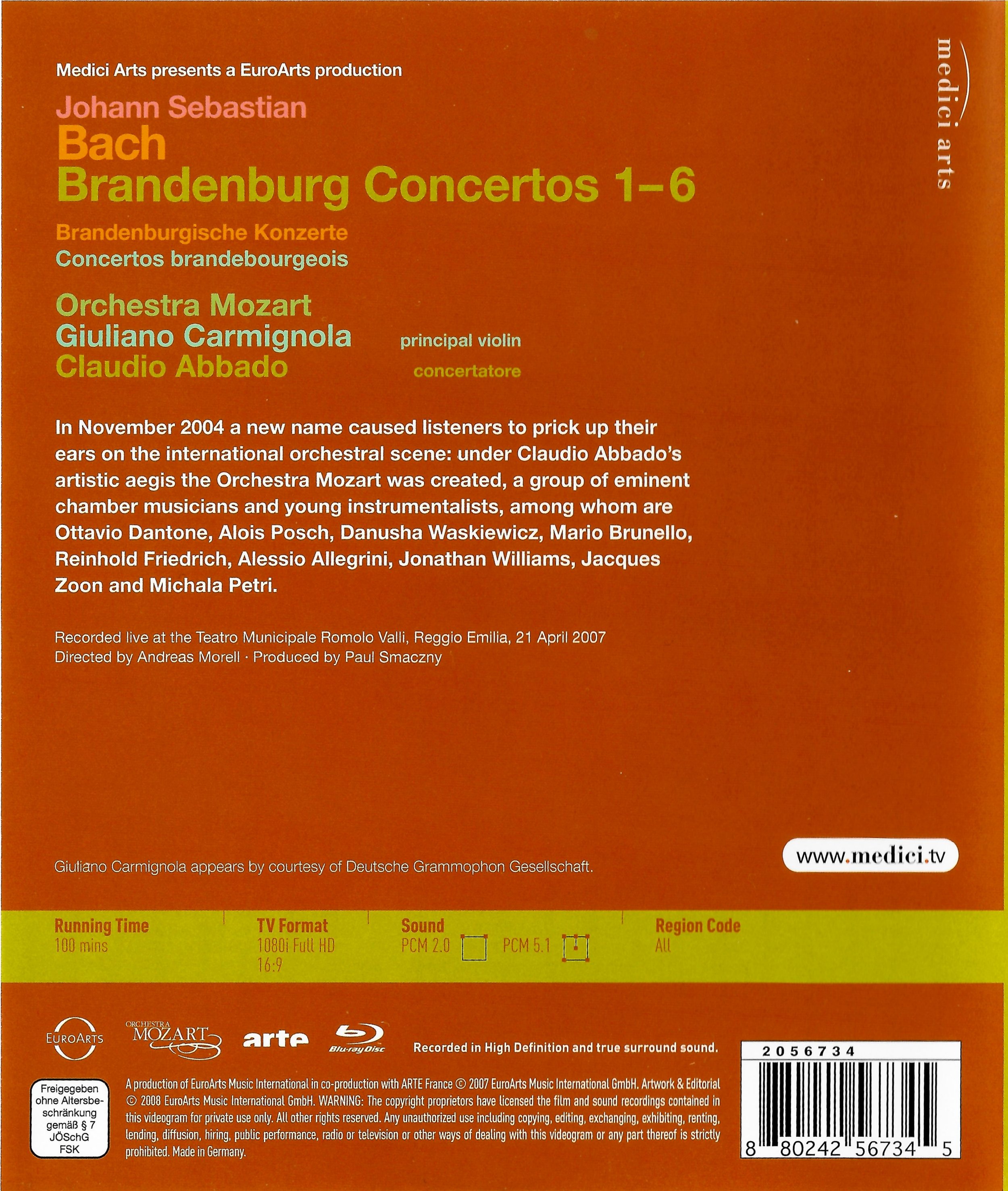



Johann Sebastian Bach Brandenburg Concertos 1-6. Claudio Abbado conducts the Orchestra Mozart in 2007, using some period instruments, at the Teatro Municipale Romolo Valli in Reggio Emilia. Directed for TV by Andreas Morell; photography directed by Andreas Naumann; produced by Paul Smaczny and Maria Stodtmeier. Disc has 5.1 PCM sound. Grade: A
This was released in 2008 by medici arts. It was re-released in 2022 by EuroArts. I believe the music on the two releases is identical. Here are the musicians in Orchestra Mozart:
Principal Violin: Giuliano Carmignola
Harpsichord: Ottavio Dantone
1st and 2nd violins: Raphael Christ, Lorenza Borrani, Yunna Shevchenko, Timoti Fregni, Etienne Abelin, Manuel Kastl, and Jana Kuhlmann
Violas: Danusha Waskiewicz, Simone Jandl, Behrang Rassekhi, and Raphael Sachs
Violas de gamba: Rainer Zipperling and Sabina Colonna Preti
Cellos: Mario Brunello, Enrico Bronzi, and Benoît Grenet
Violone: Alois Posch
Flute: Jacques Zoon
Recorders: Michala Petri and Nikolaj Tarasov
Oboes: Victor Aviat, Lucas Macias Navarro, and Guido Gualandi
Bassoon: Guilhaume Santana
Horns: Alessio Allegrini and Jonathan Williams
Trumpet: Reinhold Friedrich
If you have the slightest interest in instrumental music, you will be thrilled by this disc. A combination of seasoned veterans and beautiful young protégés go after these 6 concertos like foxes after a hare. And seeing this performance of these (so often-heard) pieces was a revelation. I had no idea how small the forces were that Bach had or how different the ensembles were for each number. These pieces were for Bach a bit like a jazz jam session— for whatever forces were available, Bach would just whip up a masterpiece.
Here are screenshots showing the instrumentation used in each of the 6 concertos plus a few close-ups of some of the star performers. If I'm not sure who is who, I list the players in alphabetical order. In all the concertos Alois Posch plays a violone, which looks like a double bass but must in fact be an earlier instrument. (The concertos were played out of numerical order on the program.)
Concerto No. 1 has the largest number of musicians. (The red harpsichord is not used):
Giuliano Carmignola, Principal Violin, plays a picolo violino in this number:
And, yes, this is the one with 3 oboes, here played by Victor Aviat, Guido Gualandi, and Lucas Macias Navarro:
And this is the only concerto with horns, played by Jonathan Williams (on your left) and Alessio Allegrini: Williams:
Concerto No. 2 is especially brilliant with 2 recorders, played with Micala Petri and Nikolaj Tarasov, and the piccolo trumpet, played by Reinhold Friedrich:
Here's a near-shot of the recorders:
A close-up of the tiny, 4-valve trumpet:
Concerto No. 3 has 10 strings plus harpsichord (red instrument not used). The string sections include violins (left toright) Giuliano Carmignola, Raphael Christ, and Lorenza Borrani; violas Simone Jandl, Behrang Rassekhi, and Danusha Waskiewicz; and cellos Enrico Bronzi, Mario Brunello, and Benoît Grenet:
A nice shot of the cellos:
Concerto No. 4 features 2 recorders. This is the only shot I could get of the whole group:
This shot shows the gentleman recorder player a bit better:
Concerto No. 5 needs 3 screenshots because the harpsichord is in the middle:
Here's a better shot of Jacques Zoon and Abbado, who, to his credit and the credit of the TV director, is rarely seen in this video:
A shot of Ottavio Dantone during his long solo:
Concerto No. 6 was written for only 7 players! This is the one number on the program where the all the instruments and musicians are identified in the title splash screen:
A nice shot of the violas de gamba, which have 7 strings:
This was recorded with standard Blu-ray 48 kHz/16-bit sound sampling, somewhat better than a CD, especially in the higher frequencies. With lossless PCM sound output, the sound on this recording is better than my earlier recordings of these concertos. It does seem to me that the keyboard was overpowered by the rest of the instruments, and I wonder if that could have been prevented with different mikes or at the mixing board.
The picture quality is excellent. There is no glare on the sheet music or reflections from the instruments. Resolution is fine although not quite as sharp as as Blu-rays would be a few years later. Colors are brilliant and natural, and there are no motion artifacts even though the musicians, many of them standing, move around a lot. I did see a few focus and field of focus issues.
The main criticism I have is of the picture content, which suffers a bit from "hyperactivity." We have published on this website standards for picture content for a HDVD recording by a symphony orchestra (where we define the dread disease called DVDitis). Here we have a small chamber outfit rather than a symphony. But the basic principle still applies: the TV director should let us see the entire band (small or large) as the starting point. He should then dwell on large-scale shots for a good long while and later move in closer for good reasons. The TV director can't do this with a DVD because of it's limited video resolution. But with HD video, views of an entire chamber orchestra can be completely satisfying to the viewer.
Unfortunately the TV director here makes us wait for a long time in most of the numbers before showing us the entire ensemble. Instead of letting us get oriented, the camera in most of the numbers jumps right into frantic action. This is not a time for, "Hey, mom, look what I can do!" The TV director should avoid too many cuts and short segments at first which tend to distract the viewer rather than help him get oriented.
Of course we don't want the video to be clinical or boring. After we have settled in with the video, we welcome shots of sections, soloists, unusual instruments, and even the conductor. But I don't think it's necessary to show the players from every possible angle (even from the side or behind) just because you can. And viewers don't benefit much from shots panning and zooming through the players. The TV director should not try to be an entertainer himself—he should be unobtrusive.
Andreas Morell is one of the best videographers in the business. I applaud him and Andreas Naumann for giving us many beautiful images here and for not cutting 100 times to the conductor. My criticism, offered I hope in a constructive way, should not detract from the fact that having this video is a huge step forward from just listening to the Brandenburg Concertos on a CD.
Now to a grade. This performance and the PQ could support an "A+." But due to the harpsichord I can't hear and hyperactive picture content, I reduce the grade to A. But I think I could make a case that this is the best recording of the Brandenburg Concertos ever made when it was published in 2008. It suspect it would hold its own in comparison to all the LPs and CDs recorded in the past of these famous works. Add the wonderful video, and this title casts a shadow over all previous recordings in all formats.
For the 2022 re-release:
For the original 2008 release:



















